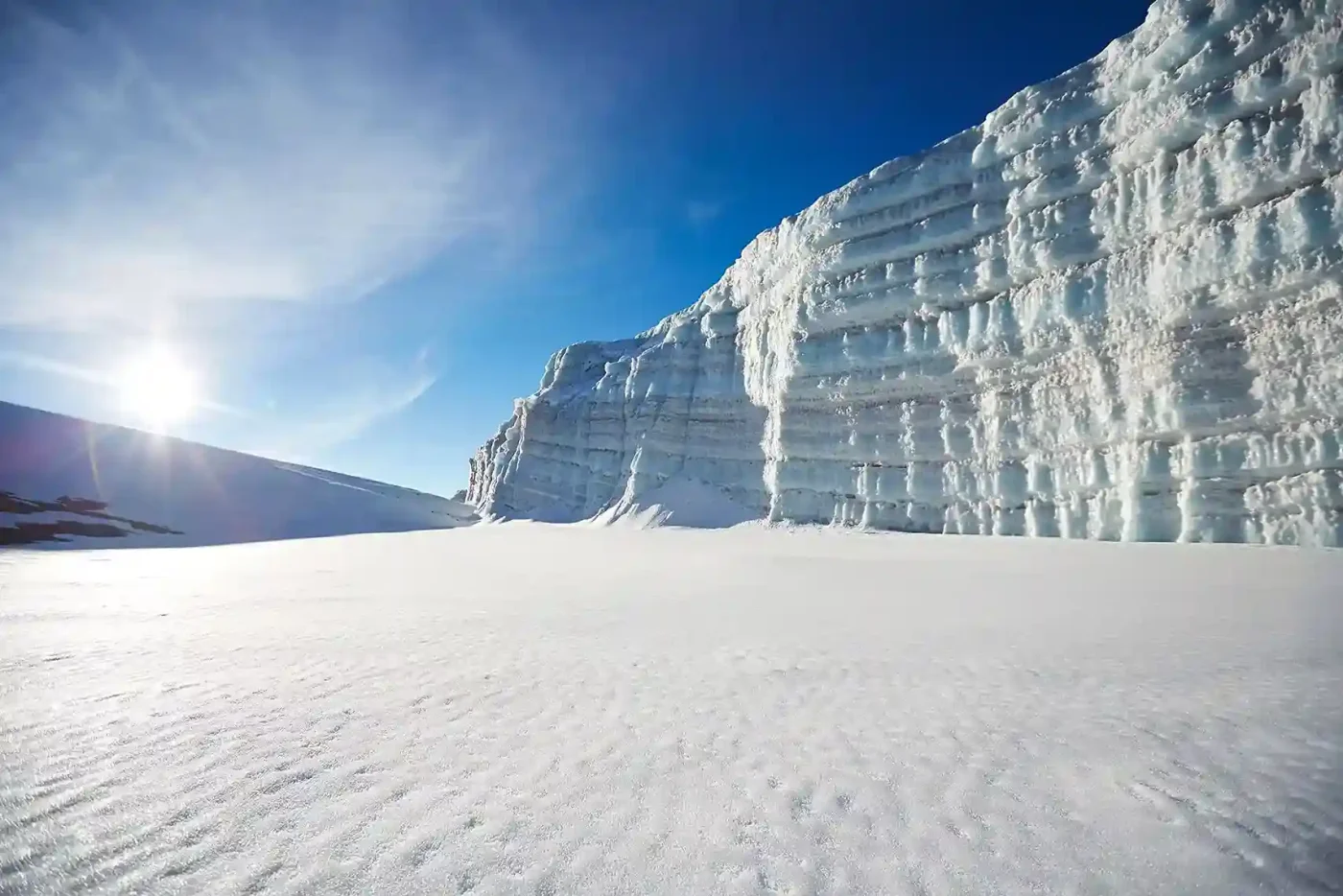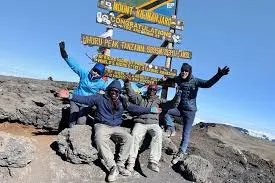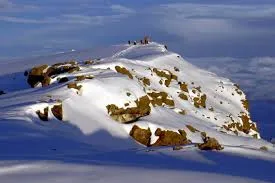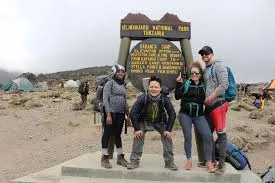The Glaciers of Mount Kilimanjaro: Past, Present & Future
Mount Kilimanjaro’s glaciers, shimmering under Africa’s highest peak, are a breathtaking yet fleeting natural wonder. These ancient ice fields, like the Furtwängler and Rebmann glaciers, have shaped the mountain’s allure for centuries but are rapidly retreating. Join Capable Africa Tours to explore their rich history, current state, and uncertain future while trekking through stunning landscapes. This guide dives into the glaciers’ past, their present challenges, and how you can witness them responsibly before they vanish.
Plan Your Glacier Trek Now
Why Kilimanjaro’s Glaciers Are a Must-See
Kilimanjaro’s glaciers are a rare spectacle—ice fields perched near the equator on Africa’s tallest mountain at 5,895 m (19,341 ft). These glaciers, including the Furtwängler, Rebmann, and Northern Ice Field, are shrinking rapidly due to climate change, making them a bucket-list destination. Trekking with Capable Africa Tours offers a chance to witness these vanishing wonders while exploring diverse ecosystems, from rainforests to arctic zones. Here’s why the glaciers captivate adventurers and scientists alike.
Key Glacier Highlights
- Unique Equatorial Ice: Rare glaciers near the equator, formed over 11,700 years ago.
- Stunning Views: Iconic ice formations near Uhuru Peak, best seen on Lemosho or Machame routes.
- Cultural Significance: Revered by local Chagga communities as sacred natural features.
- Scientific Value: Ice cores reveal climate data from thousands of years, studied globally.
- Urgency to Visit: Glaciers may disappear by 2040–2050, per scientific projections.
The Past: Formation and History of Kilimanjaro’s Glaciers
Kilimanjaro’s glaciers formed during the last Ice Age, around 11,700 years ago, when cooler climates allowed snow to accumulate on the mountain’s summit. These glaciers, covering vast areas like the Kibo Crater, have fluctuated over millennia but remained a defining feature. Historical records from early explorers like Hans Meyer in 1889 describe extensive ice fields, with some glaciers extending far below the summit. By 1912, the glaciers covered approximately 11.4 km², a stark contrast to today’s diminished state.
Historical Data
| Year | Glacier Area (km²) | Key Observation |
|---|---|---|
| 1912 | 11.4 | Extensive ice fields mapped by early explorers. |
| 1953 | 6.7 | Noticeable retreat due to warming trends. |
| 2000 | 2.5 | Significant loss, with Furtwängler Glacier thinning. |
| 2020 | 1.76 | 85% ice loss since 1912, per NASA studies. |
The Present: Current State of Kilimanjaro’s Glaciers
Today, Kilimanjaro’s glaciers are a fraction of their former size, covering just 1.76 km² as of recent estimates. The Furtwängler Glacier, once a prominent feature, is now a thin ice patch, while the Rebmann and Northern Ice Fields continue to recede. Rising temperatures, reduced snowfall, and sublimation (ice turning directly into vapor) are the main culprits. Despite their decline, the glaciers remain a stunning sight, especially on routes like Lemosho, offered by Capable Africa Tours, which pass close to these ice fields.
Current Glacier Stats
| Glacier | Location | Current Area (km²) | Status |
|---|---|---|---|
| Furtwängler | Kibo Crater | 0.06 | Critically thin, may vanish by 2030 |
| Rebmann | Southern Slope | 0.38 | Retreating, still visible |
| Northern Ice Field | Northern Slope | 0.95 | Largest remaining ice field |
Challenges Facing the Glaciers
- Climate Change: Average temperature rise of 0.1°C per decade in the region.
- Reduced Precipitation: Less snowfall to replenish ice loss.
- Sublimation: Dry air causes ice to vaporize without melting.
- Tourism Impact: Increased foot traffic near glaciers stresses fragile ecosystems.
The Future: What Lies Ahead for Kilimanjaro’s Glaciers
Scientists predict that Kilimanjaro’s glaciers may disappear by 2040–2050 if current trends continue. Some models suggest small ice pockets could persist in shaded areas, but the iconic ice fields are unlikely to survive. Capable Africa Tours promotes eco-friendly trekking to minimize impact, supporting conservation efforts and carbon offset programs. Visiting now offers a chance to witness these glaciers before they vanish, with routes designed for optimal views and sustainability.
Conservation Efforts
- Eco-Friendly Treks: Capable Africa Tours follows Leave No Trace principles.
- Carbon Offsets: Optional programs to offset your trek’s carbon footprint.
- Local Support: Partnerships with Chagga communities for sustainable tourism.
- Research Support: Collaboration with scientists studying glacier retreat.
Experience Kilimanjaro’s Glaciers Up Close
Watch this video to see the stunning glaciers of Mount Kilimanjaro with Capable Africa Tours, showcasing their beauty and the urgent need to visit before they disappear.
Best Routes to See Kilimanjaro’s Glaciers
Not all Kilimanjaro routes offer clear glacier views. Capable Africa Tours recommends the Lemosho, Machame, and Rongai routes for the best sightings, particularly near Uhuru Peak. These routes provide access to the Furtwängler and Rebmann glaciers while offering diverse scenery and high summit success rates.
Route Comparison
| Route | Duration | Glacier Views | Success Rate | Difficulty |
|---|---|---|---|---|
| Lemosho | 7–8 days | Furtwängler, Rebmann | 85–90% | Moderate |
| Machame | 6–7 days | Rebmann, Southern Ice Field | 80–85% | Moderate |
| Rongai | 6–7 days | Northern Ice Field | 80% | Moderate |
Preparing for Your Glacier Trek
Trekking to see Kilimanjaro’s glaciers requires physical and mental preparation. Focus on cardiovascular fitness, leg strength, and altitude acclimatization. Capable Africa Tours provides pre-trek training plans and gear rentals to ensure a safe, comfortable climb.
Preparation Tips
- Cardio Training: Run or cycle 4–5 times weekly for 45–60 minutes.
- Strength Exercises: Squats, lunges, and core workouts for steep ascents.
- Altitude Prep: Practice hikes above 2,500 m or use altitude simulation.
- Gear Testing: Break in boots and test layers on long hikes.
- Mental Prep: Learn about altitude sickness and pacing strategies.
Essential Gear Checklist
- Base Layers: 3–4 sets of merino wool or synthetic (200g).
- Outer Layers: Gore-Tex jacket and pants for wind and cold.
- Thermal Gear: 800-fill down jacket for summit night (0–20°F).
- Footwear: Waterproof boots, merino socks, and gaiters.
- Accessories: UV400 sunglasses, SPF 50+ sunscreen, headlamp.
- Rentals: Sleeping bags and trekking poles from Capable Africa Tours.
Best Time to Visit Kilimanjaro’s Glaciers
The dry seasons—January to March and June to October—are ideal for glacier views due to clear skies and stable weather. Avoid April–May and November for better visibility and safer trails.
Seasonal Breakdown
| Season | Months | Weather | Pros | Cons |
|---|---|---|---|---|
| Dry (Peak) | Jan–Mar, Jun–Oct | Clear, 0–80°F | Best glacier views, stable trails | Higher crowds |
| Wet | Apr–May, Nov | Heavy rain, foggy | Fewer trekkers | Poor glacier visibility |
| Shoulder | Dec, early Jun | Mixed, light rain | Moderate crowds | Unpredictable visibility |
Ready to Witness Kilimanjaro’s Glaciers?
Join Capable Africa Tours for a sustainable trek to see Kilimanjaro’s vanishing glaciers. Our expert guides, eco-conscious practices, and 90% summit success rate ensure an unforgettable adventure. Book now to secure your spot!
- 90% summit success rate with Lemosho Route
- Eco-friendly treks with carbon offset options
- Gear rentals for a hassle-free climb
- Customizable itineraries for all levels
- All-inclusive packages with meals and transfers
Limited spots available—book now to see Kilimanjaro’s glaciers before they’re gone!
Plan Your Trek Now


